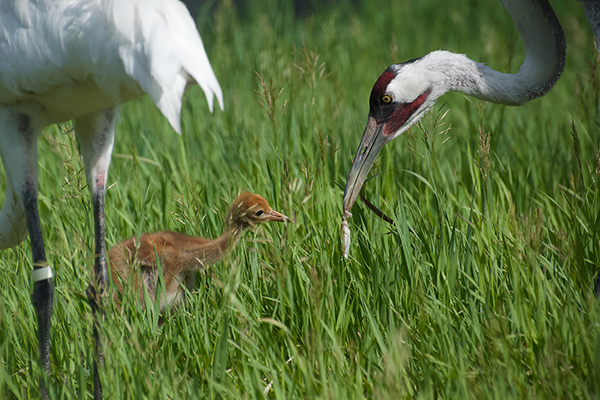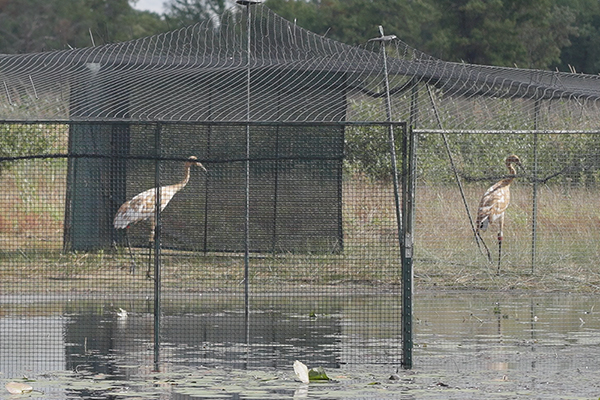
Cross-border Collaboration to Release Endangered Whooping Cranes
CONTACT:
Jodi Legge, Director of External Affairs, International Crane Foundation, 608-356-462 ext. 120;
Alison Archambault, Director, Brand & Engagement, Wilder Institute, 403-232-7766 | 403-919-9482
Oct. 5, 2023 (Baraboo, WI) – In a significant contribution to global wildlife conservation efforts, two Endangered Whooping Cranes, hatched and raised at the Wilder Institute’s conservation breeding facility in Canada, were released in Wisconsin by the International Crane Foundation (ICF) team. These iconic birds, found in only three populations across North America, were hatched and raised with the hope they will contribute to the survival of their species.
It Starts with an Egg
The Wilder Institute leads Canada’s only conservation breeding programs for the birds. They host a breeding flock of Whooping Cranes in Alberta and provide expert care to the eggs, chicks, and adults under their care. This year, two chicks, ‘Reed’ and ‘Harp,’ hatched as part of the breeding program. They were named after musical instruments to pay homage to the Whooping Crane’s trumpeting call.

“From daily feeding and monitoring to specialized veterinary care, our team works tirelessly to help these birds have a better chance at survival when they are released to the wild. Reed and Harp are a symbol of hope not just for Whooping Cranes, but for our planet’s incredible biodiversity,” said Caitlin Slade, Animal Care Manager at the Wildlife Conservation Centre/Archibald Biodiversity Centre (WCC/ABC).
United for a Common Cause
Conservation knows no boundaries, and the success of this moment speaks to the collaboration it takes to protect species at risk. The Wilder Institute and the International Crane Foundation have been working together to support Whooping cranes for more than 30 years. It’s through endeavors such as this when expertise and resources are shared, that biodiversity truly benefits.
With just over 650 Whooping Cranes left in the wild, each new addition to the population is a small victory contributing to the larger recovery efforts of its species. These cranes carry with them the potential to increase the genetic diversity of their wild counterparts and strengthen the entire population.

“The International Crane Foundation is excited to once again work across borders to release these birds at the Necedah National Wildlife Refuge in Wisconsin,” said Kim Boardman, ICF’s Curator of Birds. “ICF is dedicated to saving this species, and this release will bring the total number of Whooping Cranes released by ICF this year to nine.”
A 1,243 Mile Voyage
The process of safely transporting these precious birds across borders is no small feat. To make this international transfer possible, months were dedicated to meticulous planning, stacks of paperwork were completed, more than 100 emails were sent, and safety preparations were made. The Wilder Institute’s Manager of Zoological Records & Animal Relocations, Deanna Snell, spent more than 80 hours preparing for this shipment. “While transporting these cranes was a challenging and complex process, it’s worth it to know that every hour put in by our team supports the Whooping Crane’s recovery,” said Snell.
As these young Whooping Cranes spread their wings and take their first flights in the heart of Wisconsin’s wetlands, they highlight how conservation actions taken today can shape the future of our shared natural world.
###
The International Crane Foundation works worldwide to conserve cranes and the ecosystems, watersheds, and flyways on which they depend. We provide knowledge, leadership, and inspiration to engage people in resolving threats to cranes and their diverse landscapes. The International Crane Foundation is committed to a future where all 15 of the world’s crane species are secure. Through the charisma of cranes, we envision a future where people work together to protect and restore wild crane populations and the landscapes they depend on – and by doing so, find new pathways to sustain our water, land, and livelihoods. Visit savingcranes.org for more information.
The Wilder Institute is a global authority on wildlife conservation, reintroducing threatened species to the wild and empowering communities to conserve their own natural resources to positively impact both nature and communities. The staff and volunteers of Wilder Institute are passionate about restoring balance to wildlife and human life, together. Using innovative science, our team is working to save threatened and endangered species and return them to the wild, where our planet needs them to be. We proudly own and operate the Archibald Biodiversity Centre, a one-of-a-kind conservation breeding and research facility. Our conservation expertise is in conservation breeding and community conservation, where we collaborate with community members to positively impact both nature and local communities. Learn more at WilderInstitute.org to join us in making the world a wilder place.
